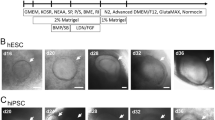Abstract
The mammalian inner ear has very limited ability to regenerate lost sensory hair cells. This deficiency becomes apparent when hair cell loss leads to hearing loss as a result of either ototoxic insult or the aging process. Coincidently, with this inability to regenerate lost hair cells, the adult cochlea does not appear to harbor cells with a proliferative capacity that could serve as progenitor cells for lost cells. In contrast, adult mammalian vestibular sensory epithelia display a limited ability for hair cell regeneration, and sphere-forming cells with stem cell features can be isolated from the adult murine vestibular system. The neonatal inner ear, however, does harbor sphere-forming stem cells residing in cochlear and vestibular tissues. Here, we provide protocols to isolate sphere-forming stem cells from neonatal vestibular and cochlear sensory epithelia as well as from the spiral ganglion. We further describe procedures for sphere propagation, cell differentiation, and characterization of inner ear cell types derived from spheres. Sphere-forming stem cells from the mouse inner ear are an important tool for the development of cellular replacement strategies of damaged inner ears and are a bona fide progenitor cell source for transplantation studies.
Access this chapter
Tax calculation will be finalised at checkout
Purchases are for personal use only
Similar content being viewed by others
References
Malgrange, B., Belachew, S., Thiry, M., et al. (2002) Proliferative generation of mammalian auditory hair cells in culture. Mech. Dev. 112, 79–88.
Li, H., Liu, H., and Heller, S. (2003) Pluripotent stem cells from the adult mouse inner ear. Nat. Med. 9, 1293–1299.
Rask-Andersen, H., Bostrom, M., Gerdin, B., et al. (2005) Regeneration of human auditory nerve. In vitro/in video demonstration of neural progenitor cells in adult human and guinea pig spiral ganglion. Hear Res. 203, 180–191.
Zhai, S., Shi, L., Wang, B. E., et al. (2005) Isolation and culture of hair cell progenitors from postnatal rat cochleae. J. Neurobiol. 65, 282–293.
Wang, Z., Jiang, H., Yan, Y., et al. (2006) Characterization of proliferating cells from newborn mouse cochleae. Neuroreport 17, 767–771.
Lou, X., Zhang, Y., and Yuan, C. (2007) Multipotent stem cells from the young rat inner ear. Neurosci. Lett. 216, 28–33.
Oshima, K., Grimm, C. M., Corrales, C. E., et al. (2007) Differential distribution of stem cells in the auditory and vestibular organs of the inner ear. J. Assoc. Res. Otolaryngol. 8, 18–31.
Senn, P., Oshima, K., Teo, D., Grimm, C., and Heller, S. (2007) Robust postmortem survival of murine vestibular and cochlear stem cells. J. Assoc. Res. Otolaryngol. 8, 194–204.
Savary, E., Hugnot, J. P., Chassigneux, Y., et al. (2007) Distinct population of hair cell progenitors can be isolated from the postnatal mouse cochlea using side population analysis. Stem Cells 25, 332–339.
Yerukhimovich, M. V., Bai, L., Chen, D. H., Miller, R. H., and Alagramam, K. N. (2007) Identification and characterization of mouse cochlear stem cells. Dev. Neurosci. 29, 251–260.
Zhang, Y., Zhai, S. Q., Shou, J., et al. (2007) Isolation, growth and differentiation of hair cell progenitors from the newborn rat cochlear greater epithelial ridge. J. Neurosci. Methods 164, 271–279.
Oshima, K., Teo, D. T., Senn, P., Starlinger, V., and Heller, S. (2007) LIF promotes neurogenesis and maintains neural precursors in cell populations derived from spiral ganglion stem cells. BMC Dev. Biol. 7, 112.
Li, H., Roblin, G., Liu, H., and Heller, S. (2003) Generation of hair cells by stepwise differentiation of embryonic stem cells. Proc. Natl. Acad. Sci. U. S. A. 100, 13495–13500.
Heller, S., Bell, A. M., Denis, C. S., Choe, Y., and Hudspeth, A. J. (2002) Parvalbumin 3 is an abundant Ca2+ buffer in hair cells. J. Assoc. Res. Otolaryngol. 3, 488–498.
Li, H., Liu, H., Balt, S., Mann, S., Corrales, C. E., and Heller, S. (2004) Correlation of expression of the actin filament-bundling protein espin with stereociliary bundle formation in the developing inner ear. J. Comp. Neurol. 468, 125–134.
Lumpkin, E. A., Collisson, T., Parab, P., et al. (2003) Math1-driven GFP expression in the developing nervous system of transgenic mice. Gene Expr. Patterns 3, 389–395.
Acknowledgments
The authors would like to thank the members of their research group for critically reading this manuscript. This work was supported by a McKnight Endowment Fund for Neuroscience Brain Disorders Award and grant DC006167 from the National Institutes of Health.
Author information
Authors and Affiliations
Editor information
Editors and Affiliations
Rights and permissions
Copyright information
© 2009 Humana Press, a part of Springer Science+Business Media, LLC
About this protocol
Cite this protocol
Oshima, K., Senn, P., Heller, S. (2009). Isolation of Sphere-Forming Stem Cells from the Mouse Inner Ear. In: Sokolowski, B. (eds) Auditory and Vestibular Research. Methods in Molecular Biology™, vol 493. Humana Press. https://doi.org/10.1007/978-1-59745-523-7_9
Download citation
DOI: https://doi.org/10.1007/978-1-59745-523-7_9
Publisher Name: Humana Press
Print ISBN: 978-1-934115-62-6
Online ISBN: 978-1-59745-523-7
eBook Packages: Springer Protocols




